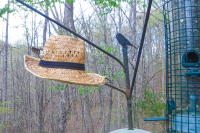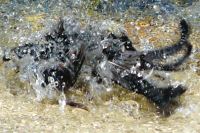Last WNC wildfires contained
For the first time since Oct. 23, Western North Carolina is free of active wildfires.
Wildfires a reminder of Nature’s power
A severe drought. A moderate but steady wind that’s coming from the north and very dry. Parched leaves swirling everywhere.
Lightning responsible for Linville Gorge fire
Lightning ignited a wildfire in the Linville Gorge Wilderness last week, but humid conditions and rainfall allowed firefighters to take an indirect approach in their response, limiting impact to the wilderness area.
More than 1,000 acres burning in mountain region
High winds over the weekend felled trees and downed power lines, sparking a wildfire that covers 950 acres straddling the jurisdictional line between the Great Smoky Mountains National Park and Swain County. Meanwhile, a fire in the Cherokee National Forest near the state line is burning 180 acres.
Firefighters respond to two Graham County fires
Firefighters responded to two wildfires late April 14 near Fontana Lake in Graham County. Both fires are burning on U.S. Forest Service land on the Nantahala National Forest Cheoah Ranger District and were 90 percent contained as of April 16.
Rain quells Cold Mountain Fire at 200 acres
A fire in the Shining Rock Wilderness Area burned about 200 acres last week after a 911 call at 3 p.m. Thursday, Nov. 21, alerted authorities to the blaze, but heavy rain Saturday helped halt its growth.
Cold Mountain fire grows, rain predicted
The Cold Mountain Fire is still burning in Haywood County, with a helicopter flight measuring it at approximately 126 acres as of noon today.
2016: Fire on the mountain
As you read this, I’ve just noted the passing of my third anniversary with this 20 year-old newspaper and as such, the retrospectives I was charged to write this week were all on events that took place long before my arrival — except for this one.
Statewide wildfire response drill comes to Haywood
In the midst of an exceptionally warm, dry winter, a wildfire erupted on Mount Lyn Lowry. About 170 acres when first reported to 911 at 10 a.m. Monday, Feb. 18, within two days the fire had destroyed roughly 60 homes and ballooned to an estimated 2,500 acres — and growing.
A fire-forged laboratory: Scientists look to learn from 2016 wildfires
When rain finally quelled the wildfires running rampant through the Southeastern U.S. last year, the public was breathing a collective sigh of relief while the scientific community spotted an opportunity. Fall 2016 was a wildfire event unlike anything seen in recent history — in the eastern part of the country, at least — and the blazes left behind a natural laboratory to study what happens on a burned landscape once the flames fade.
“It’s a unique opportunity, because the forested areas — especially the high northern hardwoods areas — burn very infrequently,” said Sarah Workman, associate director of the Highlands Biological Station.









